![]()
![]()
![]()
Use LEFT and RIGHT arrow keys to navigate between flashcards;
Use UP and DOWN arrow keys to flip the card;
H to show hint;
A reads text to speech;
198 Cards in this Set
- Front
- Back
|
Sigmoidal growth curve
|
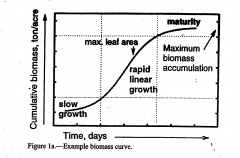
Growth charted over the course of development (S-shaped)
|
|
|
Essential elements
|
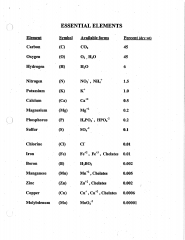
Elements required by the plant for growth and development
In particular N, P, K, Ca, Mg, and S |
|
|
Polycarpic plants
|
Plants that senesce and die after multiple reproductive cycles
|
|
|
Monocarpic plants
|
Plants that senesce and die after a single reproductive cycle
|
|
|
Summer annuals
|
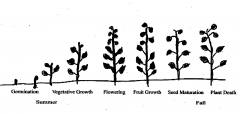
Plants that germinate spring or early summer, grow vegetatively through summer and die in late summer or fall of same growing season
|
|
|
Winter annuals
|

Plants that germinate during autumn through late winter into early spring
Germination inhibited by high soil temperatures Vegetative growth as rosette on short stem, then during spring the shoot axis elongates and they flower, set seed, and die |
|
|
Biennial plants
|

Plants that require two growing seasons to complete their life cycle
|
|
|
Woody Pperennial
|
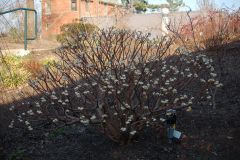
Plants with persistent, woody stems and roots
Can survive extended periods of environmental stress in state of dormancy; will resume growth when conditions favorable |
|
|
Herbaceous perennial
|
A plant whose growth dies down annually but whose roots or other underground parts survive
|
|
|
Bolting
|

Bolting refers to the rapid elongation of shoot axis
Bolting usually occurs during the second spring of a biennial plant After bolting the plant flowers, set seed, and dies |
|
|
Chilling
|
The chilling requirement of a fruit is the minimum period of cold weather after which a fruit-bearing tree will blossom. It is often expressed in chill hours, which can be calculated in different ways, all of which essentially involve adding up the total amount of time in a winter spent at certain temperatures.
|
|
|
Phenology
|
Phenology is the study of periodic plant and animal life cycle events and how these are influenced by seasonal and interannual variations in climate, as well as habitat factors (such as elevation)
We study phenology because we are concerned with occurrence in time of periodic events in relation to climate, weather, and other ecological factors |
|
|
Heat summation (degree days)
|
Quantifies the relationship between ( temperature ) and ( growth+development )
|
|
|
Chilling hours
|
Chilling hours in agriculture is a metric of a plant's exposure to chilling temperatures. Chilling temperatures extend from freezing point to, depending on the model, 45 °F (7 °C) or even 60 °F (16 °C)
|
|
|
Cell differentiation
|
Differentiation generates various tissues & organs
Variations in direction of cell division, differential wall thickening, and activities of cell organelles Starts with formation of root and shoot axis from a zygote |
|
|
Meristems
|
Growing points called meristems
Shoot apical meristem Root tips Vascular cambium |
|
|
Endogenous regulation
|
Factors that originate within plant
Hormones or other substances produced by plant Does not depend on environmental signal |
|
|
Exogenous regulation
|
Function of external factors
Photoperiod Chilling Growing degree days |
|
|
Chronology
|
The arrangement of events or dates in the order of their occurrence
Simplest way to time cultural practices Can be based on calendar date Elapsed time from benchmark like (planting or date of bloom) Chronology poor predictor; year to year variation of environment; particularly temperature Chronology useful predictor in controlled environmental conditions |
|
|
Double fertilization
|
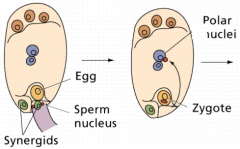
Sperm cells reach embryo sac one unites with egg cell
Results in diploid, single-celled zygote Other sperm cell unites with two polar nuclei, each are diploid Triploid endosperm 1x + 1x + 1x = 3x endosperm Called double fertilization because two fertilization events occur Sperm cell + egg cell = zygote (becomes embryo) Sperm cell + two polar nuclei = endosperm |
|
|
Pollination
|
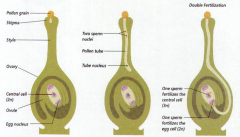
Pollen lands on stigma, travels down style to ovule, enters embryo sac where fertilization occurs
In pollen tube are two sperm cells Each of these cells are haploid |
|
|
Polar nuclei
|
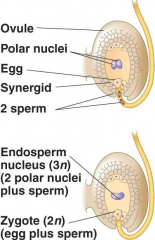
Two haploid nuclei in the embryo sac
These nuclei fuse with a pollen nucleus to form a triploid endosperm nucleus, which subsequently divides to form the endosperm |
|
|
Egg cell
|

Female gametophyte
Found inside the ovule which is inside the ovary |
|
|
Zygote
|
A diploid cell resulting from the fusion of two haploid gametes
A fertilized ovum |
|
|
Diploid
|
(of a cell or nucleus) containing two complete sets of chromosomes, one from each parent.
2n |
|
|
Triploid
|
(of a cell or nucleus) containing three homologous sets of chromosomes
Triploid endosperm 1x + 1x + 1x = 3x endosperm |
|
|
Protoderm
|
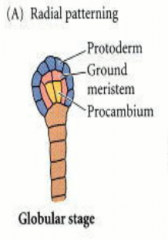
In the golbular stage of embryo development, a few cells that give rise to the epidermis
Protoderm - lies around the outside of the stem and develops into the epidermis |
|
|
Ground tissue
|
Tissue found between epidermis and vascular cylinder
The ground tissue of plants can be divided into three classes based on the nature of the cell walls Parenchyma, Collenchyma, and Sclerenchyma The ground meristem gives rise to ground tissue |
|
|
Radial patterning
|
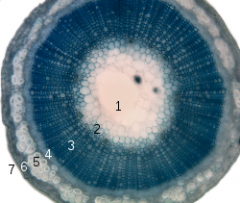
Gives rise to three tissue systems
Epidermis, ground tissue, and vascular tissue |
|
|
Endosperm
|

The tissue produced inside the seeds of most flowering plants around the time of fertilization
It surrounds the embryo and provides nutrition in the form of starch, though it can also contain oils and protein |
|
|
Apical-basal axis
|
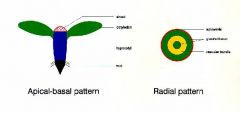
Is a development pattern that describes the polarity from apical (top) to basal (bottom)
|
|
|
Globular stage
|
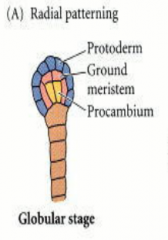
Embryo has cells that give rise to three tissue systems of plant
Suspensor stops growing by this stage |
|
|
Testa
|

Seed coat
|
|
|
Radicle
|

Root of embryonic plant
|
|
|
Plumule
|

Shoot of embryonic plant
|
|
|
Cotyledon
|

An embryonic leaf in seed-bearing plants, one or more of which are the first leaves to appear from a germinating seed
Endosperm digested and stored energy in cotyledons: exalbuminous |
|
|
Hypocotyl
|
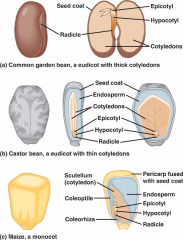
The part of the stem of an embryo plant beneath the stalks of the seed leaves, or cotyledons, and directly above the root
|
|
|
Epicotyl
|
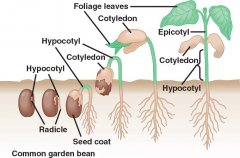
Portion of shoot above cotyledons
|
|
|
Hypogeous germination
|
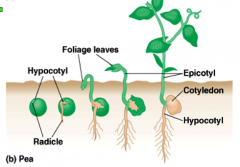
Little elongation of hypocotyl (stem below cotyledons)
Cotyledons remain below ground (hypo=below; geo=earth) |
|
|
Epigeous germination
|
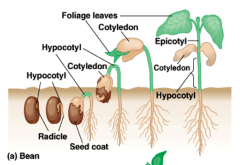
Hypocotyl elongates and carries cotyledons above ground (epi=above)
|
|
|
Seed priming
|

A form of seed planting preparation, in which seeds are soaked before planting
|
|
|
Thermo-dormancy
|
Temperature above optimum inhibit germination & induce secondary seed dormancy
Seeds are very sensitive to thermo-dormancy immediately after chilling |
|
|
Primary dormancy
|
Dormancy caused by factors arising normally during growth and development
Present at time of maturity and dispersal |
|
|
Secondary dormancy
|
Occurs when seed exposed to adverse conditions
Changes from being quiescent to truly dormant |
|
|
Quiescent
|
in a state or period of inactivity or dormancy
|
|
|
Hardseededness
|
A form of exogenous dormancy
Seed has a hard seed coat |
|
|
Scarification
|
Artificial means to weaken seedcoats & promote germination
Applied to seeds in hardseeded exogenous dormancy Files, sandpaper, knives, acid, and hot water |
|
|
After-ripening
|
Time required in dry storage to break non-deep physiological dormancy of seeds
|
|
|
Cold stratification
|
Pre-germination chilling used to break deep physiological dormancy of seeds
Growers can sow seeds in fall to let nature perform cold stratification Provide warm stratification to develop embryo then cold stratification to break deep physiological dormancy |
|
|
Warm stratification
|
Heating of seeds to develop embryo
Provide warm stratification to develop embryo then cold stratification to break deep physiological dormancy |
|
|
Apomixis
|
Seeds that develop asexually
Formation of seeds without fertilization Genetically identical to mother plant |
|
|
Morphological dormancy
|
A rudimentary or underdeveloped embryo in an otherwise apparently mature seed
A form of endogenous dormancy |
|
|
Physiological dormancy
|
Another class endogenous dormancy
Metabolic activity of mature embryo low due to: physiological inhibiting mechanisms Three types: Non-deep (shallow) physiological dormancy Intermediate physiological dormancy Deep physiological dormancy |
|
|
Non-deep physiological dormancy
|
Caused by nucellus and other living tissues surrounding embryo
Broken by either after-ripening or red light |
|
|
Intermediate physiological dormancy
|
Caused by inner, living portion seed coverings & endosperm
Embryos grow without chilling if excised from seed coverings and given nutrients Common in conifers Chilling not required but promotes germination and seedling growth |
|
|
Deep physiological dormancy
|
Caused by the embryo itself
Even if excised from seed coverings embryo will not grow without chilling Broken with cold stratification |
|
|
Activation
|
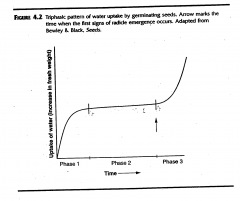
First stage of seed germination
Germination begins as dehydrated tissue which imbibes water Seed swells, fresh weight increases and seedcoat softens Growth systems in dehydrated tissues becomes activated Cell membranes reorganize Gibberellins, RNA, ATP activated Enzymes activated and newly synthesized Storage compounds converted to simple sugars to produce ATP needed for germination Respiration rate increasing Activation = Phase 1 in graph provided |
|
|
Photodormant
|
A form of non-deep physiological dormancy that can be broken by either light or dark
|
|
|
Shoot apical meristem
|
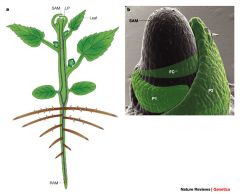
Extreme tip of shoot
Only includes apical dome Maintains stem-cell like organization Perpetuates itself so always undifferentiated cells to become various tissues and organs of plant Exhibits totipotency |
|
|
Totipotency
|
Ability to differentiate into any organ
|
|
|
Determinate
|
The shoot apical mertistem ends with some structure other than continuous vegetative growth
Such as tendrils, flowers, thorns, etc. |
|
|
Indeterminate
|
The shoot apical meristem in leaves of brances which are capable of continuous vegetative growth
|
|
|
Central Zone (SAM)
|
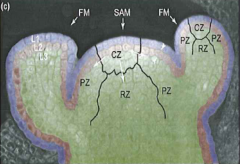
In cytohistochemical zonation, the central zone is the source cells with infrequent divisions
Denoted as CZ in image |
|
|
Peripheral Zone
|

In cytohistochemical zonation, the perpheral zone is the most morphogenic area
Results in lateral organ formation Small cells with rapid division Denoted as PZ in image provided |
|
|
Rib Meristem Zone
|

In cytohistochemical zonation, the rib meristem is centerally located
Gives rise to stem tissue Denoted as RZ in image provided |
|
|
Phytomere
|
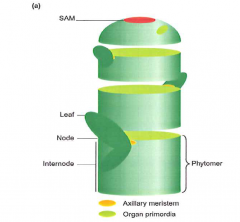
A developmental unit consisting of
One or more leaves The node to which leaves are attached The internode below the node One or more axillary buds |
|
|
Phyllotaxy
|

Arrangement of leaves around the stem
Determined by position, timing, and number of successive primordia development |
|
|
Alternate
|
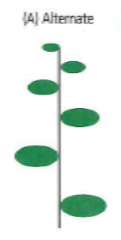
Leaf attachments are singular at nodes, and leaves alternate direction, to a greater or lesser degree, along the stem
|
|
|
Opposite
|
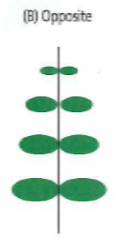
Leaf attachments are paired at each node
|
|
|
Decussate
|

Leaf attachment is opposite and each successive pair is rotated 90° progressing along the stem
|
|
|
Whorled
|

Three or more leaves attach at each point or node on the stem and each attachment is rotated by half the angle between the leaves in the whorl
(i.e., successive whorls of three rotated 60°, whorls of four rotated 45°, etc.) |
|
|
Auxin
|
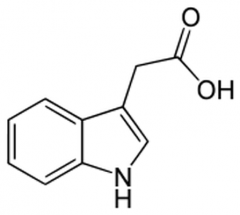
Is boss
A class of plant hormones (or plant growth substances) with some morphogen-like characteristics Auxins have a cardinal role in coordination of many growth and behavioral processes in the plant's life cycle and are essential for plant body development |
|
|
Tunica-corpus
|

Organizational pattern of the shoot apical meristem
Composed of three histogenic layers L1 and L2 = tunica L3 = corpus Anticlinal divisions Perpendicular to meristem surface |
|
|
Histogenic layers
|
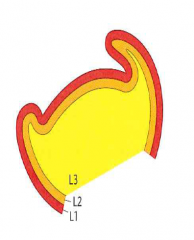
Tissue producing layers of the shoot apical meristem
L1, L2, and L3 |
|
|
L1 histogenic layer gives rise to
|
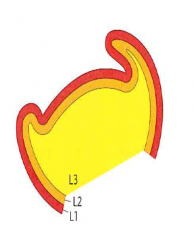
the epidermis
|
|
|
L2 and L3 histogenic layer gives rise to
|
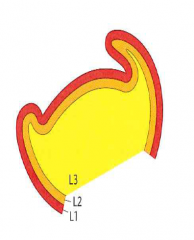
internal tissues
|
|
|
Cytohistochemical zonation
|
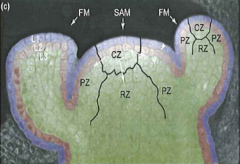
Organizational pattern of the shoot apical meristem
Super-imposed upon the tunica-corpus |
|
|
Plate meristem
|
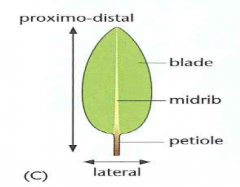
In leaf development, the plate meristem is the formation of the lateral axis
Forms most of the leaf blade area |
|
|
Marginal meristem
|
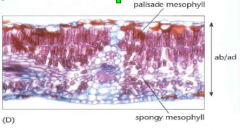
In leaf development, the marginal meristem forms the adaxial-abaxial axis
Produces the number of cell layers; ie leaf thickness |
|
|
Adaxial surface
|
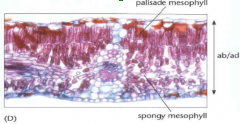
Upper surface of the leaf that faces sun
Photosynthesizing mesophyll cells near adaxial surface, densely packed as palisade mesophyll |
|
|
Abaxial surface
|
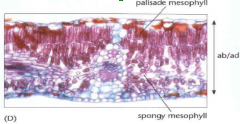
Lower surface of the leaf
Cells loosely arranged to allow diffusion of gases through tissue, forming the spongy mesophyll Stomata are more abundant |
|
|
Stomata
|
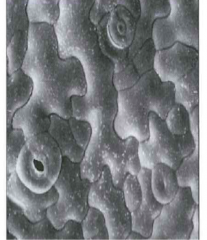
Pores that are primarily used for gas exchange and controlling transpiration
Typically found on the abaxial surface of the leaf |
|
|
Epidermis
|
Outermost layer of cells; includes other specialized cells
|
|
|
Palisade mesophyll
|

Contains most chlorophyll in leaf; site of photosynthesis
|
|
|
Spongy mesophyll
|
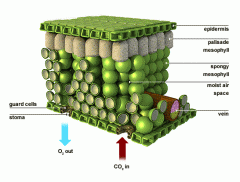
Fewer chloroplasts in leaf; site of gas exchange
|
|
|
Guard cells
|
Pairs of cells that control the opening and closing of stomata
|
|
|
Fixed growth (pre-form or determinate)
|
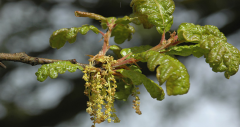
Elongation of preformed shoots within a bud
Single flush followed by a resting bud |
|
|
Free growth (neo-form or indeterminate)
|
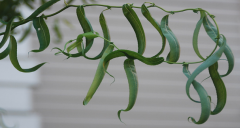
Shoot elongation of leaves within bud followed by sustained initiation of new leaves
Often with heterophyllus shoots Free growth produces long shoots |
|
|
Recurrent growth
|
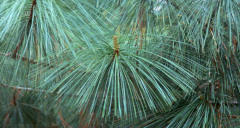
Expansion of preformed, compressed shoot followed by setting of terminal bud, followed by more shoot expansion
Multiple flushes of growth in a year depending on growing conditions |
|
|
Determinate
|
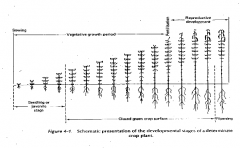
Synonym of fixed growth, and pre-form shoot growth patterns
Determinate plants not a lot of overlap between vegetative growth and reproductive growth |
|
|
Indeterminate
|

Synonym of free growth, and neo-form shoot growth patterns
Indeterminate plants continue vegetative growth simultaneously with reproductive growth |
|
|
Early leaves
|
Leaves that are present in the bud
|
|
|
Late leaves
|
Leaves that are produced during the current growing season
|
|
|
Short shoots
|

Shoots that early leaves are born on
Shoots resulting from fixed growth |
|
|
Long shoots
|
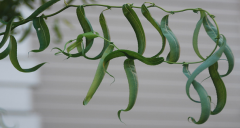
Shoots that late leaves are born on
Shoots resulting from free growth |
|
|
Heterophyllous shoots
|
Shoots that both early and late leaves are born on
Shoots resulting from free growth |
|
|
Evergrowing
|
Apical meristem grows and constantly forms new leaves throughout year
No dormant buds form |
|
|
Intermitted (periodic)
|
A tropical tree pattern of shoot growth
A true resting bud forms Three subtypes: deciduous, leaf exchange, evergreen |
|
|
Deciduous periodic
|
Leaves shed weeks to months before buds open
A subtype of intermitted shoot growth, a tropical tree pattern of shoot growth |
|
|
Evergreen periodic
|
Leaf shed happens well after bud opening
A subtype of intermitted shoot growth, a tropical tree pattern of shoot growth |
|
|
Leaf exchange
|
New leaves emerge as the old ones shed
A subtype of intermitted shoot growth, a tropical tree pattern of shoot growth |
|
|
Apical control
|

Uppermost shoots suppress subtending lateral branches and cause them to grow at an oblique angle
Effects of apical control are manifested throughout the plant, and throughout its life |
|
|
Apical dominance
|
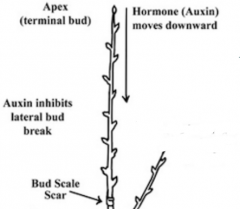
Complete inhibition of lateral buds during current growing season
Effects of apical dominance are only during the current growing season, on single branch |
|
|
Excurrent
|

Overall growth pattern of many conifers
Strong orthotropic leader Branches at more or less regular intervals Branches smaller than leader, grow at wide angles |
|
|
Decurrent
|

Overall growth pattern of many deciduous trees
Several competing branches of roughly similar size No central leader Develops through bifurcation of main branches |
|
|
Plagiotropism
|
Issue in propagation of excurrent species, where lateral branches return to the orientation they had on the tree
Plagiotropism is a form of topophysis Upright branches grow upright, while lateral branches grow laterally |
|
|
Topophysis
|
Tendency of cutting or scion to perpetuate type of growth it had while attached to parent plant
|
|
|
Ecodormancy (quiescence)
|
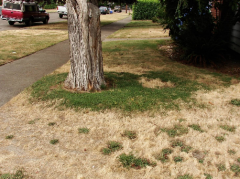
Dormancy imposed by environmental factors unfavorable for normal growth processes
Correct environmental conditions and growth resumes |
|
|
Paradormancy
|
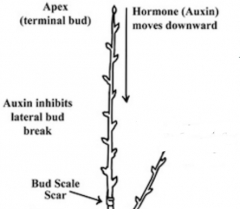
Dormancy controlled from a different structure than where dormancy is manifested
Para-means “other than” Apical dominance is a good example of paradormancy Broken by removing bud in the case of apical dominance |
|
|
Endodormancy
|
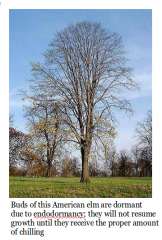
Dormancy regulated by physiological factor(s) within the structure
Endo- “within” Broken by providing chilling Structures include buds, seeds, and bulbs |
|
|
Latent buds
|
Suppressed axillary buds from previous seasons
Embedded in older parts of trunk and branches |
|
|
Dark dominant species
|
Species that exhibit a dark dominant response
Bud set determined by duration of uninterrupted dark Night interruption prevents or delays bud set |
|
|
Light dominant species
|
Species that exhibit a light dominant response
Inhibition of bud set depends on total duration and quantity of light Low intensity night interruption ineffective Higher latitude species or provenances |
|
|
Ripe to flower
|
Competent to respond to environmental cues to induce flowering
Plants must be reproductively mature to flower synonym to 'competent to flower' |
|
|
Competent
|
Can respond to environmental cues to induce flowering
Plants must be reproductively mature to flower Marks transition from juvenile to adult form synonym to 'ripe to flower' |
|
|
Juvenile plant
|

Vegetative growth stage
Unable to induce flowering |
|
|
Transition phase
|
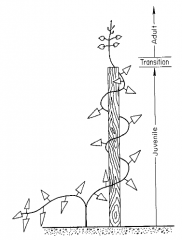
Appears vegetative but internally is in transition to reproductive phase
|
|
|
Adult phase
|
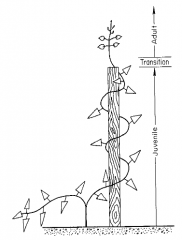
Reproductive phase
Able to induce flowering |
|
|
Cone of juvenility
|
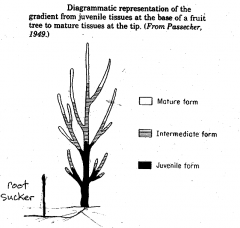
Gradient of juvenile tissue at the base of a tree to the adult tissue at the top of a tree
|
|
|
Epicormic shoots
|
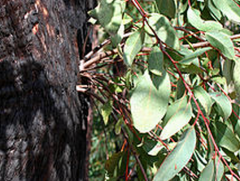
A shoot growing from an epicormic bud which lies underneath the bark of a trunk, stem, or branch of a plant
|
|
|
Floral evocation
|
First stage of the flowering process
Molecular and cellular changes in the shoot apical mertistem lead to the differentiation of floral primordia |
|
|
Floral initiation
|

Second stage of the flowering process
First morphological evidence that the meristem has differentiated flower parts |
|
|
Floral organogenesis
|
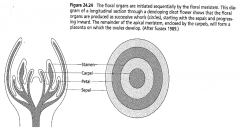
Third stage of the flowering process
Continued growth and differentiation |
|
|
Anthesis
|
Fourth and final stage of the flowering process
Flower opening Do not confuse anthesis (flower opening) with anther dehiscence (pollen shed) |
|
|
Florigen
|
Hormone-like molecules responsible for controlling and/or triggering flowering in plants
|
|
|
Photoinductive cycle
|
Includes periods of light and dark received by plant which induce flowering
|
|
|
Obligate response (qualitative)
|
Flowers only if certain conditions are met such as day length or chilling requirement
|
|
|
Facultative response (quantitative)
|
Plant will flower in the absence of ideal conditions but flowers better when conditions are ideal
Conditions such as day length and chilling |
|
|
Vernalization
|
Foral evocation and initiation caused by a period of chilling
|
|
|
De-vernalization
|
Can be brought about by exposing previously vernalized plants or seeds to high temperatures, causing a reversion to the original nonflowering condition
|
|
|
Vegetative adult
|

Trees that are not flowering but are not juvenile
Adult scion wood used to propagate |
|
|
Alternate (biennial) bearing
|
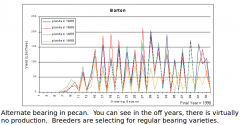
Cycle of years with heavy fruit crops followed by years with light crops
|
|
|
Earliness (chronological)
|
Days from germination to flowering
Measured from calendar date of germination to calendar date of flowering |
|
|
Earliness (developmental)
|
Number of nodes produced before flowering
Measured by orthotropic growth and observed morphological change |
|
|
Flowering concentration
|
Number flowers that reach anthesis per day
|
|
|
Bloom density
|
Relation of the number of flowers to the size of the plant
|
|
|
Skotoperiod
|
The duration of uninterrupted dark
|
|
|
Pollination
|
The transfer of pollen to stigma
|
|
|
Fruit set
|
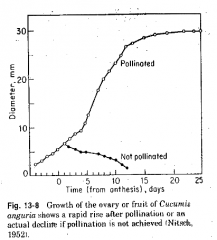
Initial persistence and swelling fruit following pollination
|
|
|
Sigmoidal growth, in relation to fruit mass
|

The apple and pear in the graph provided
|
|
|
Double sigmoidal growth, in relation to fruit mass
|

The peach in the graph provided
|
|
|
Parthenocarpic fruit
|
Fruit without seeds
|
|
|
Vegetative parthenocarpy
|
No pollination, which yields a seedless fruit
|
|
|
Stimulative parthenocarpy
|
Pollination but no fertilization, which yields a seedless fruit
|
|
|
Stenospermocarpy
|
Pollination and fertilization, but embryos abort early, which yields a seedless fruit
|
|
|
Episodic drop
|
A predictable premature abscission of fruit
|
|
|
Physiological maturity
|
The culmination of the maturation process
|
|
|
Autocatalytic
|
In fruit ripening, ethylene stimulates a climacteric, which produces ethylene
|
|
|
Respiratory climacteric
|
Fruit ripening marked by a rapid increase in respiration rate
|
|
|
Horticultural maturity
|
Has attributes for use by consumers
Fruit that is ready to harvest Fruit may or may not be physiologically mature |
|
|
Senescence
|
Programmed cell death
|
|
|
Self-pollination
|
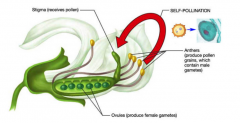
The stamens and the sticky stigma of the same plant contact each other in order to accomplish pollination
Genetically identical plant to mother plant |
|
|
Cross-pollination
|
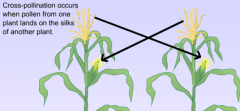
Pollen from a genetically different plant, reaches the stigma
|
|
|
Self-compatible
|
Pollen produced by the plant is capable of functioning in pistils of flowers on the same plant or clone
|
|
|
Self-incompatible
|
Pollen produced by a plant is not capable functioning in pistils of flowers of the same plant or clone
|
|
|
Cross-compatible
|
Plant A pollen is capable of functioning in pistils of plant B and vice versa
|
|
|
Cross-incompatible
|
Plant A pollen is not capable of functioning in pistils of plant B and vice versa
|
|
|
Stigma receptivity
|
A period of time when stigmas provide the environment conducive for pollen germination
|
|
|
Effective pollination period (EPP)
|
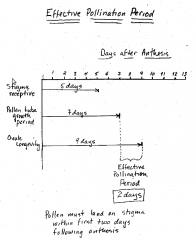
Period of time when pollination will likely result in fertilization
EPP = Ovule longevity - Pollen tube growth period |
|
|
Ovule longevity
|
Functional life expectancy of a flower following anthesis
EPP = Ovule longevity - Pollen tube growth period |
|
|
Pollinator
|
Agent that transfers pollen
eg. insects and wind |
|
|
Pollinizer
|
The source of pollen
|
|
|
Maturity indices
|
Physical indices such as size, shape, firmness, skin color, flesh color, seed development, and percent moisture
Chemical indices such as sugar content, acidity, sugar:acid ratio, oil content Other indices such as growing degree day accumulation |
|
|
Cold acclimation
|
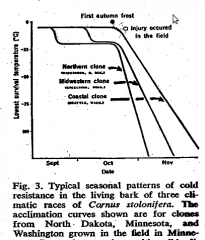
The process of increasing freezing resistance
|
|
|
Cold deacclimation
|
The loss of freezing resistance
|
|
|
LT-50
|
The temperature at which 50% of a plant population dies
|
|
|
Freezing injury
|
Associated with ice formation within plant tissue
Ice can form intracellular and intercellular Intracellular ice causes freezing injury |
|
|
Chilling injury
|
Some tropical species of plants are injured at 10 to 15 degrees Celsius
|
|
|
Hardiness zones
|
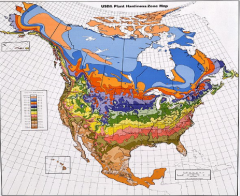
The U.S. has 11 hardiness zones based on average annual minimum temperature
|
|
|
Winter injury
|
Damage from phenomena associated with sub-freezing temperatures such as frost heaving, freeze desiccation, and ice smothering
|
|
|
Frost heaving
|
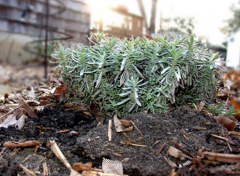
Lifting of soil occurs when poorly drained soils freeze
Plants lifted out of ground, which can separate crowns from roots |
|
|
Ice smothering
|
Ice coats the plant and inhibits gas exchange
|
|
|
Freeze desiccation
|
Cold inhibits water uptake and movement of water to the leaves
|
|
|
Freezing point depression
|
The lowering of a freezing point due to the presence of solutes
Phloem has a lower freezing point than Xylem due to the presence of sugars in solution |
|
|
Supercooling
|
The temperature of water in plant tissue drops well below freezing but there is no ice formation because the water does not have an ice nucleator to orient upon
|
|
|
Ice nucleators
|
Particles that promote ice crystallization by orienting water molecules
|
|
|
Equilibrium freezing
|
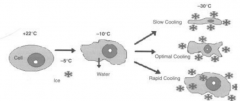
Water slowly turns to ice
Leads to the development of small, imperfect ice crystals between cells Does not cause automatic death Lower chance of intracellular ice formation Increased intercellular ice formation |
|
|
Non-equilibrium freezing
|
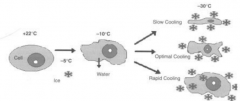
Lots of water quickly turns to ice
Always lethal Intracellular ice formation |
|
|
Freezing avoidance
|
A function of freezing point depression and supercooling
During hardening solutes depress freezing point and supercooling takes place Enhanced by decreased water content and increased cuticle thickness |
|
|
Freezing tolerance
|
Trait that allows tissues to survive ice formation
Associated with the ability to withstand cell dehydration and extracellular ice formation Enhanced by the reduction in water content during hardening |
|
|
Desiccation postponement
|
The ability of the plant to maintain tissue hydration in drought condition
Involves the closing of stomata to prevent water loss |
|
|
Desiccation tolerance
|
The ability of the plant to function while dehydrated
|
|
|
Drought escapers
|
The life cycle of a plant is completed during wet conditions
|
|
|
Thermotolerance
|
Brief exposure to high temperatures (but below lethal temperatures) can induce tolerance to higher temperatures
|
|
|
Temperature compensation point
|
At certain temperature there is an equal amount carbon dioxide fixed by photosynthesis and released by respiration
Temperatures higher than this will result it a net loss of carbon |
|
|
Sodicity (sodic soils)
|
Soils that contain high levels of sodium (Na)
|
|
|
Salinity (saline soils)
|
Soil that contain high levels of total salts (Ca2+, Mg2+, SO42-, NaCl)
|
|
|
Halophytes
|
Plants are native to saline soils and are well-adapted
|
|
|
Glycophytes
|
Plants that are not able to tolerate salts as well as halophytes
|
|
|
Anoxia (anoxic conditions)
|
No available oxygen
|
|
|
Hypoxia (Hypoxic conditions)
|
Low levels of oxygen
|
|
|
Water use efficiency
|
Amount of tissue produced per unit of water
|
|
|
Water deficit
|
Water content of tissue or cell is below maximum hydration
First reduction in leaf expansion Reduced leaf area = reduced photosynthesis = less sugars for growth |
|
|
Photomorphogenesis
|
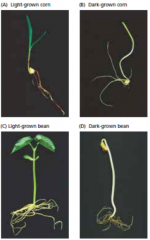
The amount and quality of light have a significant effect on plant growth and development
|
|
|
Etiolated growth
|
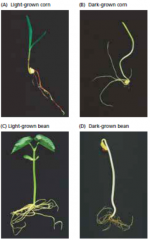
Grass growing under board or seedlings in complete darkness result in etiolated growth
|
|
|
Photoreversibility
|
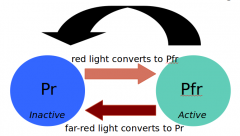
Involves phytocrome red and phytochrome far red
Exposure to red light and far-red light causes quick conversion There is also slow conversion to Pr that occurs during darkness |
|
|
Shade avoidance (Phototropism)
|
The ability of a plant to grow towards the light
Phytochrome allows plants to adapt to light environment |
|
|
Photoperiodism
|
The ability of a plant to respond to changes in timing of day-to-night transitions
|

